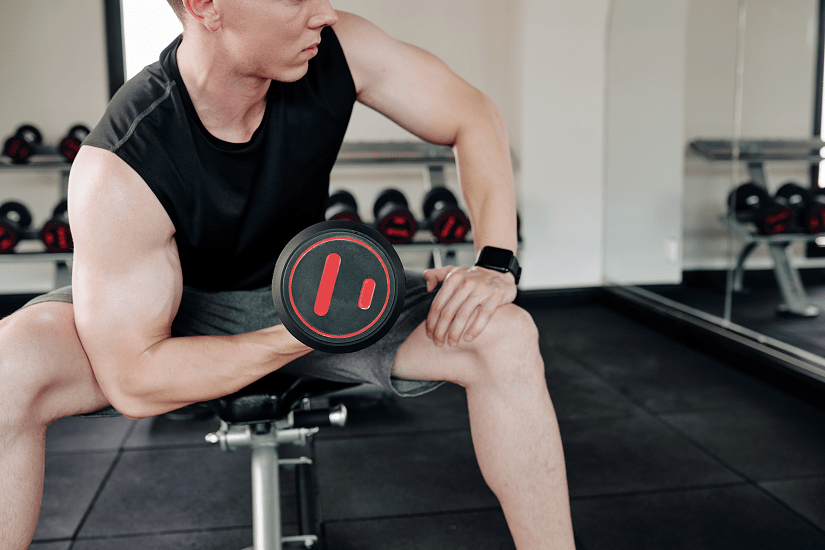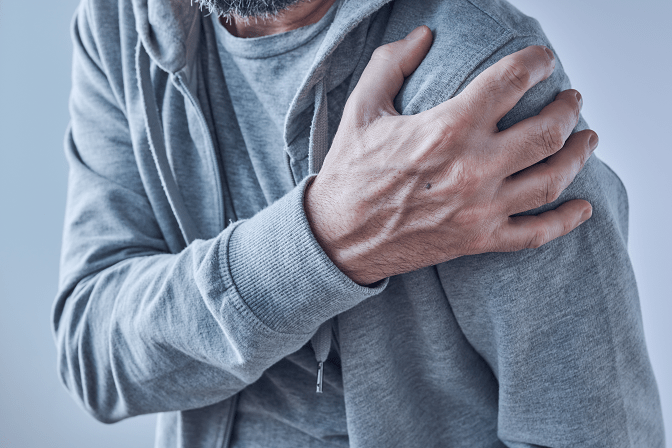Online Enquiry Form

Overview
Biceps tendonitis commonly affects those over 40s, whereby the tendon of the biceps muscle which passes through the front of the shoulder and attaches to the top of the shoulder becomes inflamed and develops tendonitis. Also known as the long head of biceps tendonitis, the condition causes a dull pain at the front and top of the shoulder and is usually of gradual onset with increasing intensity over time. Biceps tendonitis is caused by repetitive overhead activities and sports which cause wear and tear on the tendon.
If biceps tendonitis isn’t treated and the activities causing the condition are allowed to continue beyond 6 months, the condition can develop into chronic biceps tendonitis which is a much more difficult condition to treat.
Symptoms of the condition include pain, inflammation and swelling, and it is often found in association with other shoulder conditions such as SLAP tear and rotator cuff tear due to the repetitive wear and tear nature of the injury and the risk of degenerative shoulder conditions with increasing age. It is important to get your shoulder pain diagnosed by a professional so that you can manage your condition correctly.

Symptoms
Biceps tendonitis may exhibit the following symptoms:
- Dull ache at the top and front of the shoulder.
- Associated clicking or snapping in the shoulder.
- Aggravated pain by combined shoulder and elbow activity.
Causes
Biceps tendonitis may be caused by:
- Overloading the biceps muscle, particularly caused by activities above the height of the shoulder.
- Overusing the biceps muscle, particularly caused by activities above the height of the shoulder.
- Wear and tear of the biceps tendon, caused by poor shoulder movement.
Biceps tendon injury is typically caused by high-velocity repetitive arm movements, like pitching a ball or pulling a rope, that overload the biceps tendon attachment in the shoulder. These types of injuries are often slow-onset injuries that worsen over time, however, if the movement is forceful enough, they may cause immediate pain and instability. Wear and tear injury of the biceps tendon is common where there is poor shoulder movement, such as in cases of poor shoulder positioning caused by pain, fatigue, over developed shoulder muscles on one side of the shoulder, or poor activity technique.
Causes can also include sports and workplace injuries.
Biceps tendonitis may begin as a relatively minor condition causing pain, inflammation and swelling of the tendon, however, if you do not treat biceps tendonitis early and the cause of the condition is not interrupted over a period of 6 months or more, biceps tendonitis may progress and become a chronic condition causing chronic shoulder pain.

Diagnosis
To diagnose biceps tendonitis, the following will be taken into consideration:
- Understand the nature of the injury (sports, work, accident, overuse etc).
- Determine the cause of the injury (impact, collision, fall, repetitive/slow onset).
- Understand the context of the suffering (age, return to sport, work, impact on daily living).
- Perform a physical examination to ascertain pain and stability.
- Perform specialised shoulder tests to confirm diagnosis.
A positive biceps tendonitis condition will present with:
- Aggravated pain when touching the bicipital groove of the upper arm.
- Aggravated pain with combined elbow and shoulder activities, like a chin-up movement.
- A clicking sensation associated with combined elbow and shoulder activities.
- Positive MRI.
Early diagnosis and treatment of biceps tendonitis are extremely important to avoid chronic repercussions. Chronic biceps tendonitis may develop into a degenerative condition that will adversely affect the tendon and structures around it

Treatment
Treatment of biceps tendonitis should always begin with a thorough diagnosis of your condition to understand the severity of the condition in the context of your age, your sport, your work and your life. Biceps tendonitis injuries may be treated conservatively (non-surgically) with rest, anti-inflammatory medication or steroid injection for pain and inflammation and with physiotherapy treatment for improved strength, better posture and shoulder function. Surgery for biceps tendonitis is usually reserved for patients with additional conditions affecting their shoulder like SLAP tear or rotator cuff tear, however, some patients with high demand for sport or work activities may be indicated for surgery for biceps tendonitis alone. Biceps tenodesis surgery is the most common type of surgery used to improve biceps tendonitis. The goal of biceps tenodesis surgery is to cut the tendon free from the top of the shoulder and reattach it to the upper arm.
Surgical Treatment
Depending on your age, Dr Gupta will choose between a smaller arthroscopic technique, or a stronger, slightly larger, mini-open technique. Arthroscopic technique is for older patients who are experiencing shoulder pain from multiple sources. The mini-open technique is for athletic patients who perform repetitive high-demand shoulder movements.
Arthroscopic Biceps Tenodesis
This procedure is useful in shoulder degeneration cases where biceps tendonitis is just one of the reasons for shoulder pain. Other reasons for shoulder pain may be bony spurs in the shoulder causing abrasion, or a rotator cuff tear. In this case, the biceps tendon is caught with a suture before it is cut free from its attachment at the shoulder. It is then anchored back to the upper arm close to where it was cut with a soft tissue anchor.
Mini Open Biceps Tenodesis
This procedure commences with the suturing of the long head of the biceps tendon arthroscopically before cutting and releasing it from its attachment at the shoulder. Dr Gupta then makes a mini-open cut in the upper arm over the bicipital groove where he will use an interference screw to firmly resecure the tendon to the upper arm.

Post Operative Rehabilitation
You will achieve the best surgical outcome if you follow up surgery with a matching course of rehabilitation. Following surgery, Dr Gupta will outline the most appropriate rehabilitation protocol for your physiotherapist to follow and communicate with your healthcare team to ensure that you receive the best post-operative treatment.
Please contact our friendly team on 02 9687 8344 or make an online enquiry here.

Dr Manish Gupta | MBBS FRACS FAOrthoA
Dr Manish Gupta is a renowned expert surgeon in the field of orthopaedic surgery specialising in upper limb including shoulder, elbow and wrist.